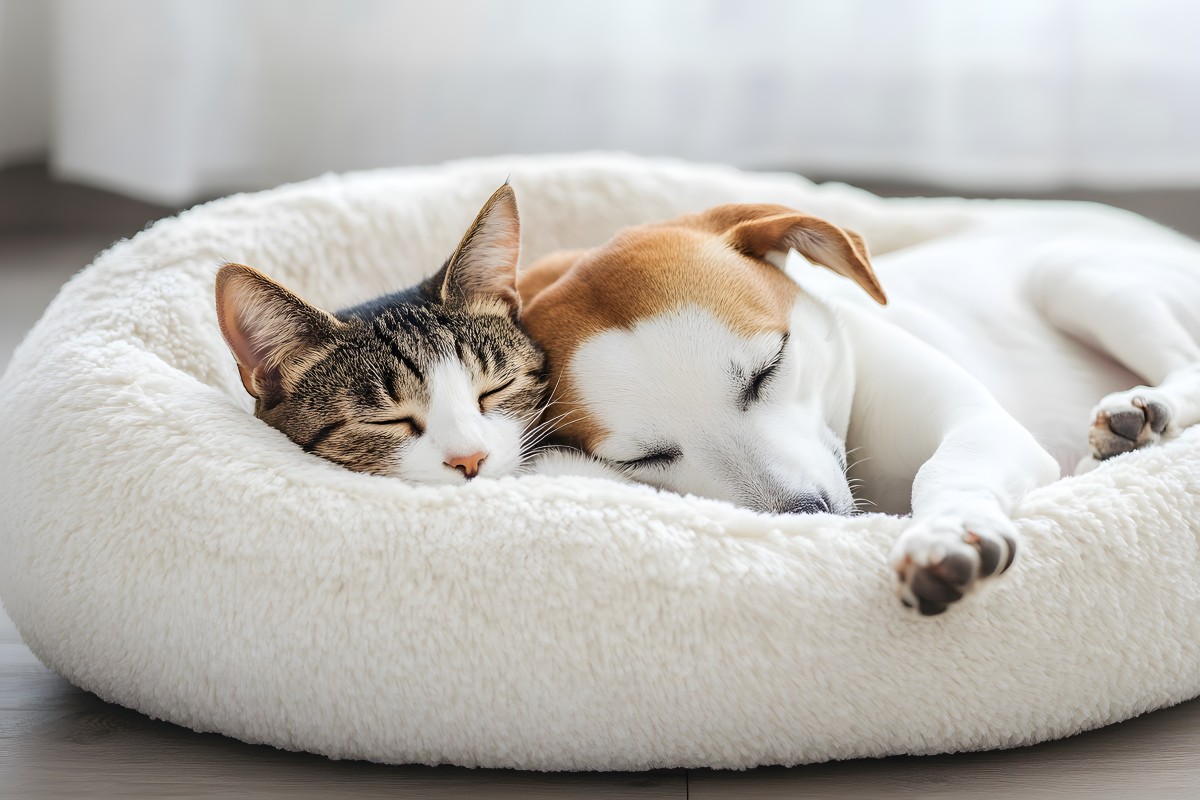
Leading International Pet Behaviourist Explains the Best Way to Sleep Divorce Your Pet
A lot of us love sharing our beds with our four-legged friends. Whether it’s your cat curled up next to you or your dog keeping your feet warm in the winter months, many Brits let their pets share their bed.
But what if you’ve had enough? What if it’s time for your furry family member to sleep in their own comfy bed? If that’s the case, it might be time for a pet sleep divorce.
In advice curated specifically for us, leading international pet behaviour expert Dilly Kitchew Williamson, who works with a variety of high net worth individuals including Royals, aristocrats and celebrity clients, has revealed why sleeping with your cat or dog is a bad idea, and why sleep divorcing your pet would always be top of her to-do list for her clients to ensure a quality night’s sleep for both owner and pet.
So if this sounds familiar, keep reading!
Why we shouldn’t share a bed with our pets
As Dilly explains, “It’s never a good idea to start sleeping with your pet in the bed as it’s such a hard habit to break. What’s more, it can be dangerous and brings little to no benefits for either of you - separate sleep is the best thing for both human and animal well-being.”
And despite what you might think, not all pets want to share a bed with us. Some pets like their own space, or others (especially cats) want the freedom to move around the house as they wish during the night, for example, to find somewhere cooler or quieter. Your dog or cat may also want to use their litter tray or the pet door to go in the garden as you sleep. If this is the case, your furry friend will let you know.
“Pets who don’t want to be shut in the same bedroom will show restlessness – often panting, pacing, pawing at you, and possibly being quite vocal. It might be the case that they actually want to start sleeping in their own space.”
Dog breeds that don’t benefit from sharing a bed
Sharing a bed might be particularly troublesome for owners of dog breeds who are prone to sleep problems, such as bulldogs, whose short, flat faces and narrowed airways make them vulnerable to snoring and Sleep Apnoea.
Also, more ‘clingy’ dog breeds such as golden retrievers, cocker spaniels and labradors might also take to sleeping in their owners’ bed more than other breeds and be harder to eject once they’ve started.
Likewise, any cat owner will tell you that they can’t be reasoned with, and can be stubborn when they don’t get their own way.
Making the case for the pet sleep divorce
Dilly told us that sleep divorcing your pet might actually improve your relationship with your four-legged friend.
“People sometimes think that being as close as possible to your pet all the time, even in bed, is a way to strengthen your bond. In truth, it’s healthy to have time apart from your pet and to set boundaries, which in turn can improve the quality of time that you do spend with them.”
If you don’t want your dog or cat in bed with you, the best advice is to not let them in the first place, but what if you already have?
With sleep divorce popular amongst couples who aren’t always compatible in the bedroom, how can you adapt this concept to your furry friend at bedtime? Dilly explains how to transition a pet to their bed, whether they are asking for it or not!
Dilly’s 3 tips for sleep divorcing your pet
Sleep divorcing your pet may not be easy, and you can expect some whining, crying and scratching at the door, but it’ll be worth it, especially if you follow Dilly’s expert advice below:
- “Start by making the basket or bed you want to transition the pet to more rewarding than yours. Something plush, soft and close to your bed would work nicely. Dogs like to be cocooned in a soft surface, and cats will often like to hide away in a covered area, so choose something appropriate to the type and breed of your pet.”
- “Let them know it’s bedtime with a toy or a chew that they can take into their basket or bed at bedtime only. This, done over a few nights, will signal that this is their time to settle down and go to sleep, and acts as a reward for getting into their own space and not your bed.”
- “For dog owners, make sure your dog has been to the toilet and had a small drink before taking them upstairs to bed. Even if they’re not sharing a bed with you, you don’t want to be disturbed in the night with them getting up, so it may be necessary to reschedule their habits to get them into a good nighttime routine.”
Our brand manager, Rachel Marsall, adds:
"While we all love snuggling with our pets, sharing a bed with them can bring a host of unwanted side effects, from disrupted sleep to allergy flare-ups. Choosing to 'sleep divorce' your pet isn't about losing that bond; it’s about protecting your own rest and sleep quality. You can still enjoy cuddling on the sofa, but it’s clear to them that your bed should remain a pet-free sanctuary, just for you.”
If you’ve successfully managed to sleep divorce your pet, and are looking for more expert advice, head over to our sleep hub. You’ll get everything from decorating and styling tips, expert insight into how to improve your sleep, and all the best bed advice.
And to celebrate your new pet-free bedroom, why not treat yourself to a new bed or mattress to really make the most of it?

Gemma Henry - Content Lead
Gemma finds sleep fascinating and describes the discovery aspect of her role as eye-opening. Her keen eye for detail and dedication to thorough research ensures that Bensons customers get the informative sleep-based advice they're looking for.